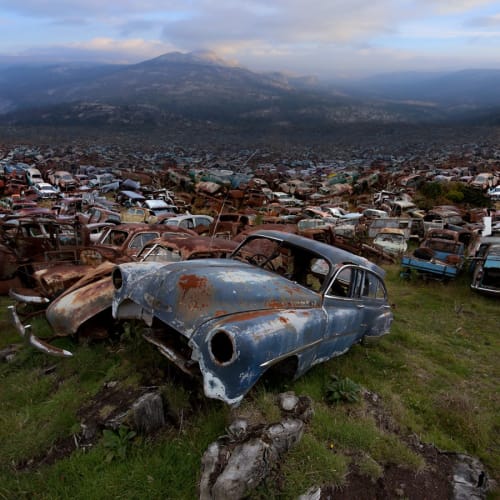“Paterson is an astute observer of the contemporary condition, an artist with political conscience, creating images that tease, disturb and disrupt the viewer’s expectations by turn, while employing allusions that function with meticulous craft and sly ingenuity.”[2]
Modernity has been out of favour since the late 60s when capitalism and consumerism and its omnivorous feeding habits began to be questioned by artists, philosophers and commentators alike.
Perhaps the abiding symbol of that shift in thinking can be detected in architecture where Modernist forms came to signify all that was wrong and life-denying about the Modern period. Born of a utopian impulse, utility and functionalism with its reductionist aesthetic – repetition, uniformity and monumentality – was something that later generations experienced as seriously flawed.
The dream failed spectacularly and artist PJ Paterson in his latest series of photographic works explores the on-going permutations from that fallout as it touches us today, providing a satirical critique of the heroic machine age.”[1]
Revelation 8:7 continues Paterson’s concern with notions of decay, destruction and obsolescence. Manipulated digital photography is employed to reframe the familiar and imagine an end-point for our society of excess, brutally deconstructing modern myths such as the success of capitalism and consumerism.
Discarded, wrecked cars are Paterson’s allegory for over-consumption. The rusting remains of countless vehicles gush, envelope, and surge through the landscape like violent tidal waves; their sheer volume overwhelms. The perfect symbol for mass production, Paterson’s cars suggest innumerable other squandered, jettisoned items. The viewer is acutely aware of the devastating bulk of a society’s waste, lingering long after it has been forgotten.
Paterson exploits the perception of photography as a documentary medium, allowing the viewer their inevitable “is it real?” moment before closer examination reveals the artifice behind each image. Distinctive moody skies and undulating mountainsides consciously evoke the New Zealand landscape, making each scene even more confronting in its familiarity.
By employing classical, symmetrical compositions and following the traditional formulas used in landscape painting, Paterson creates a startling beauty in his works. This offers an uncomfortable disjuncture for the viewer, as the otherwise troubling images have immediate aesthetic appeal.
Biography
Born: Manchester, United Kingdom
Lives: Auckland
Awards/Distinctions: The Wallace Art Awards - Finalist (2013, 2012, 2009)
Collections: The James Wallace Arts Trust, Auckland; The University of Waikato, Hamilton
Public Exhibitions: The Care Factor, Calder & Lawson Gallery, The University of Waikato, Hamilton (2013); Air New Zealand Fashion Week - Invited artist, Auckland (2010)
Publications/Articles: ‘Compassion and Global Concern’ by Peter Dornauf, www.eyecontactsite.com, 4 Mar, 2013; The Care Factor Exhibition Catalogue, The University of Waikato, Hamilton, 2013; ‘Moments fixed in time with still-life skills’ by Terry McNamara, The New Zealand Herald, Apr 2011; ‘Innocent victim or malevolent goddess?’, Art News New Zealand, Autumn 2010
[1]Peter Dournauf, 2013
[2]Peter Dournauf, 2013
